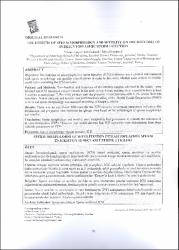| dc.contributor.author | Karpuz, Vildan | |
| dc.contributor.author | Göktürk, Aslı | |
| dc.contributor.author | Koyutürk, Meral | |
| dc.date.accessioned | 2014-08-15T13:13:44Z | |
| dc.date.available | 2014-08-15T13:13:44Z | |
| dc.date.issued | 2007 | |
| dc.identifier.citation | Karpuz V, Gokturk A, Koyuturk M. The effects of sperm morphology and motility on the outcomes of intracytoplasmic sperm injection. Marmara Medical Journal. 2007; 20(2); 92-97. | en_US |
| dc.identifier.issn | 1019-1941 | |
| dc.identifier.uri | http://www.marmaramedicaljournal.org/ | en_US |
| dc.identifier.uri | https://hdl.handle.net/11446/450 | en_US |
| dc.description | İstanbul Bilim Üniversitesi, Tıp Fakültesi. | en_US |
| dc.description.abstract | Objective: The outcome of intracytoplasmic sperm injection (ICSI) treatments was evaluated and compared
with sperm morphology and motility classifications in order to determine whether strict criteria or motility
could aid in predicting the ICSI outcome.
Patients and Methods: Two-hundred and forty-two of the infertile couples admitted to the clinic, were
selected and ICSI treatment was performed. In the study group, female partners were required to have at least
5 oocytes at metaphase II. For male partners only the presence of spermatozoa cells in the semen fluid was
necessary. Semen analysis and motility was performed according to the World Health Organisation (WHO)
criteria and sperm morphology was assessed according to Kruger’s criteria.
Results: There was no significant difference for the ICSI outcome assessment parameters indicating that
fertilization and pregnancy rates between the groups were based on the percentages of sperms morphology
and motility.
Conclusion: Sperm morphology and motility were accepted as best parameters to evaluate the outcomes of
in vitro fertilization (IVF). However, our results showed that ICSI outcomes were independent from these
valuable parameters for IVF. | en_US |
| dc.description.abstract | Amaç: İntrasitoplazmik sperm enjeksiyonu (ICSI) tedavi sonuçları, sperm morfoloji ve motilite
sınıflandırmaları ile karşılaştırılarak değerlendirildi; bu çerçevede Kruger kesin kriterlerinin veya motilitenin,
bu sonuçları tahminde yardımcı olup olamıyacağı araştırıldı.
Yöntem: Kliniğe başvuran infertil çiftlerden, 242 si seçilerek ICSI tedavisi uygulandı. Çalışma grubundaki
kadın partnerlerde Metafiz II oosit sayısı en az 5 ve üzerinde, erkek partnerlerde ise yanlızca semen sıvısında
sperm bulunması gereği öngörüldü. Semen analizi ve motilite değerlendirmesi Dünya Sağlık Örgütü (WHO)
kriterlerine göre gerçekleştirildi; sperm morfolojisi ise “Kruger’in kesin kriterleri”ne göre değerlendirildi.
Bulgular: Sperm morfoloji ve motilite yüzdelerine göre oluşturulan gruplar içerisinde ICSI sonuçlarını
değerlendirme parametrelerinden, fertilizasyon ve gebelik oranları arasında anlamlı bir fark saptanmadı.
Sonuç: Sperm motilite ve morfolojisi in vitro fertilizasyon (IVF) sonuçlarının değerlendirilmesinde en iyi
parametreler olarak kabul edilmektedir. Oysa ki bizim bulgularımız ICSI sonuçlarının IVF için değerli olan
bu parametrelerden bağımsız olduğunu göstermektedir. | en_US |
| dc.language.iso | eng | en_US |
| dc.publisher | Marmara Üniversitesi Tıp Fakültesi | en_US |
| dc.relation.uri | http://www.marmaramedicaljournal.org/pdf/pdf_MMJ_418.pdf | en_US |
| dc.rights | info:eu-repo/semantics/openAccess | en_US |
| dc.subject | sperm morphology | en_US |
| dc.subject | sperm motility | en_US |
| dc.subject | ICSI | en_US |
| dc.subject | sperm morphology | en_US |
| dc.subject | sperm motility | en_US |
| dc.title | The effects of sperm morphology and motility on the outcomes of intracytoplasmic sperm injection | en_US |
| dc.title.alternative | Sperm morfolojisi ve motilitesinin intrasitoplazmik sperm enjeksiyon sonuçları üzerine etkileri | en_US |
| dc.type | article | en_US |
| dc.relation.journal | Marmara Medical Journal | en_US |
| dc.department | DBÜ, Tıp Fakültesi | en_US |
| dc.identifier.issue | 2 | |
| dc.identifier.volume | 20 | |
| dc.identifier.startpage | 92 | |
| dc.identifier.endpage | 97 | |
| dc.contributor.authorID | TR9511 | en_US |
| dc.contributor.authorID | TR140953 | en_US |
| dc.relation.publicationcategory | Belirsiz | en_US |


















